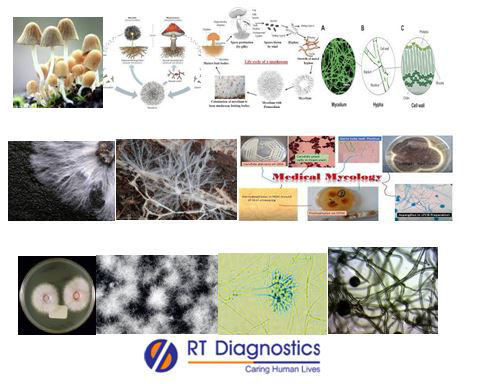Mycelia – Fungal Test:
Why Mycelia Fungal Test ?
CLINICAL INFORMATION
Fungi are microbes that exist in nature (single celled - yeast, branched filamentous - molds). Most of them are harmless but a few types are infectious. Modes of spread of fungal infection in humans includes contact with contaminated soil and or decaying plants/rotting woods (i.e organic decaying of moist/damp leaves or rotting woods on wet soil), animal bite or scratch (often cats), unhygienic habits such as sharing clothes from other fungal infected person (skin), unsanitary food preparations, weak immune system (immunocompromised) eg. HIV/AIDS, patient under immune suppressive medications etc. Hyphae and mycelium are parts of fungi. Mycelia is the vegetative part of a fungus, consisting of a network of fine filaments also called hyphae (consist of a cell wall made of chitin that forms the structural part of the body of fungus and hyphae are the building block of a fungus). The fungus body has a collection of hyphae referred to as mycelium. Mycelium is interwoven filamentous mass of hyphae that forms particularly the vegetative part (thallus) of a multicellular filamentous fungus, which is most often penetrated in another body (eg. soil, organic matter, tissue of the host etc, which releases enzymes and absorbs nutrients from a food source). Two types of mycelium are septate (they are divided into discreet cells by cell walls) and coenocytic (undivided septa that form a continuous tubular network). In human beings, many fungi are parasitic in nature and are pathogenic. Fungi most commonly enter the human body through the skin wound (a breach in the epidermis) and/or access of the fungal spores by inhalation or accidental consumption of leftover stale food (without reheating) eg. bread mould which may exhibit clinical manifestations of food poison etc. Some of the examples of human diseases caused by fungi include athlete’s foot, ringworm, aspergillosis, histoplasmosis, coccidioidomycosis, Candida Albicans (yeast) causing oral thrush etc, certain fungi when reach (invasive) systemic circulation can damage heart and brain (i.e in case of fungal meningitis – hence CSF sample specimen is preferred for diagnosis, with symptoms of severe persistent headaches, stiff neck, sensitivity to light etc), thus can be life-threatening. Common types of fungal infections include tinea infections eg. tinea corporis (ringworm), tinea pedis (athlete's foot), tinea cruris (jock itch) etc. There are two types of fungal infections – Superficial (affecting the parts of the outer body) and systemic (affecting systems inside the body eg. Lung etc). Typical signs and symptoms of a fungal infection in the skin are itchy, red skin and scales. The nail infection may show symptoms of yellow, thick and brittle nails. Signs of fungal infection of the mouth (oral candidiasis with oral thrush) include white patches on the tongue, inner cheeks and gums. Vaginal infection of the fungi may show vaginal discharge and itching. Symptoms of a systemic fungal infection include fever, muscle aches, headaches, chills, nausea, rapid heartbeat etc. Specimen collection depends on the type and site of fungal infection manifested in the patient. Superficial infection– specimen may be skin or nail scraping, oral or vaginal infection– the special swab is used to collect tissues or fluid from a suspected infected part like mouth or vagina, tissue biopsy etc. Some of the sample specimens include blood, skin, nails, mucosal surfaces – such as wounds or the fungal infected genital regions etc. The blood test is used to detect the presence of fungi in the blood eg. During systemic infection (such as septicemia) antigen/Antibody testing eg. ELISA etc. Urine tests may be performed for vaginal infections or UTI etc. Sputum specimen is preferred in thick coughed up sputum that may help to diagnose fungal infection in the lungs. Additional tests include microscopic examination (eg. KOH i.e potassium hydroxide preparation, Calcofluor white stain), antigen or antibody testing in blood specimens, molecular testing, histo-pathological tests (tissue biopsies), and CSF specimens (meningitis) with symptoms of severe persistent headaches, stiff neck, sensitivity to light etc. Other tests are imaging studies like CT Scan, MRI Scan, Ultrasound etc.

General Instructions:
Sample Requirement: Specimen - Sample collected from the infected region. Test Preparation: None.
NOTE - Sample for specimen collections may vary based on the patient’s condition/cases according to the patient’s presenting complaints/signs or symptoms:
SPECIMEN REQUIREMENT (Special or Rare Cases) - As instructed and guided by Physician / Clinician / Pathologist / as per Laboratory’s requirements, according to procedures and protocols.
This Multi-Specialty Clinical Referral Laboratory RT DIAGNOSTICS provides precise and accurate tests with an extensive range of testing services to the medical centres to help in the diagnosis and identification of pathology in the test specimens for infectious diseases and also to evaluate the function of organ systems of the patient. It prevents further complications and helps to stabilize and restore health to near normalcy at the earliest without delay.



